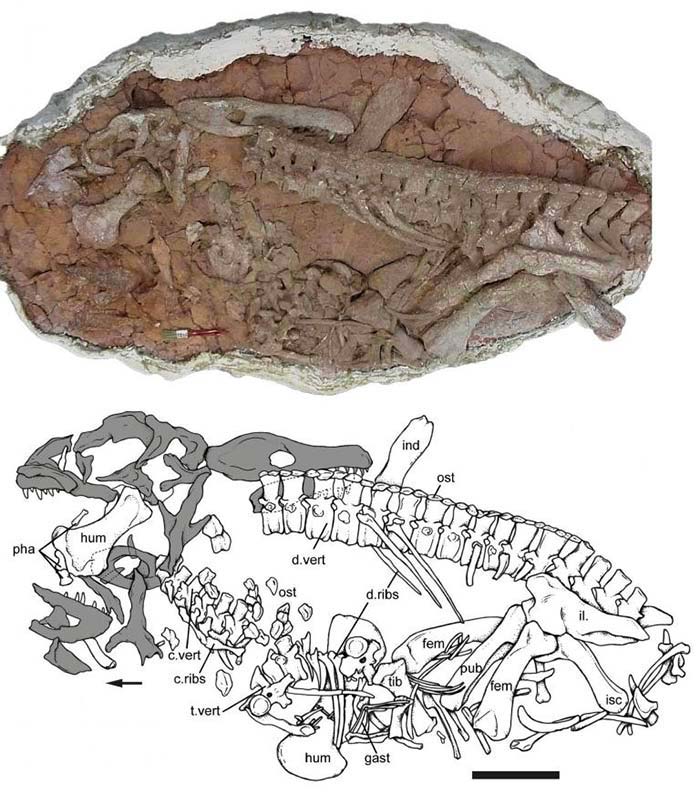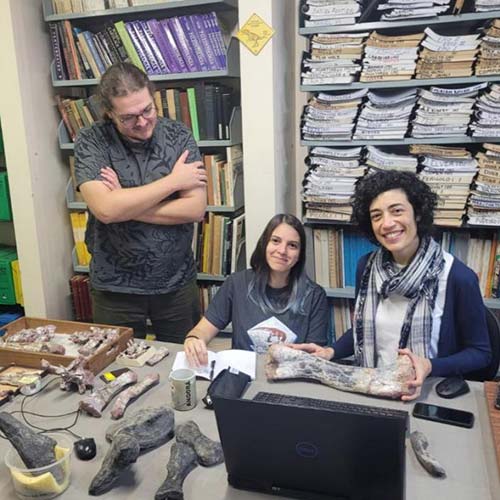O The most complete fossil of Prestosuchus chinikensis, an apex predator around 240 million years old, was recently detailed in a study published in the American scientific journal The Anatomical Record. Led by paleontologist Bianca Mastrantonio, from the Federal University of Rio Grande do Sul (Ufrgs), the research included the collaborative effort of scientists from four institutions in two different countries. The fossil, discovered in rocks in the town of Dona Francisca, was analyzed by experts from the UFSM Paleontological Research Support Center (Cappa).
Bianca Mastrantonio highlights the importance of Prestosuchus, recognizing it as one of the largest predators of its time and a milestone in the state’s paleontological history. The species, initially identified in 1928 by an expedition from the University of Tübingen, Germany, was previously known only through partial and fragmented skeletons. Professor Cesar Schultz, from Ufrgs and co-author of the study, highlights the previous difficulty in associating different fossils with the same species due to the lack of overlap in bone elements.
Julia Desojo, a paleontologist at the National University of La Plata, Argentina, and a participant in the research, celebrates the discovery, which includes the almost complete preservation of the skull and most of the postcranial skeleton, making this specimen a crucial reference material for the species. Researcher Marcel Lacerda, from the National Museum, points out that this finding now allows comparison with other fragmentary specimens, consolidating the identification of the species.
Quadrupedal and carnivorous, Prestosuchus is the ancestor of current alligators and crocodiles, according to the evolutionary analysis of paleontologist Letícia Rezende de Oliveira, from Cappa/UFSM. Histological analyzes carried out at the National Museum, especially on a fragment of the humerus, revealed that the animal was in a stage of slow growth and was an adult, as indicated by paleontologist Brodsky Farias, from Ufrgs.
Flávio Pretto, from Cappa/UFSM, notes that the size of the studied specimen, estimated at just over four meters, was relatively modest compared to other larger fossils of the same species. The fossil is now part of the Ufrgs collection, with a replica available to the public in São João do Polêsine, in the Cappa permanent exhibition.

In conclusion, Bianca Mastrantonio highlights the continuous journey of discoveries about the biology of Prestosuchus, even almost a century after the discovery of the first fossils, emphasizing that there is still much to be explored and understood about this remarkable species.
Prehistoric treasures in the heart of Rio Grande do Sul
A central region of Rio Grande do Sul, in Brazil, is a true cradle of paleontological discoveries, presenting an impressive wealth of prehistoric animal fossils. This area stands out on the world stage for the abundance and diversity of fossil records, which provide valuable insights into life on Earth millions of years ago.

The geological history of this region is particularly conducive to the preservation of fossils. During the Triassic period, approximately 250 million years ago, what we now know as the central region of Rio Grande do Sul was part of a vast ecosystem that was home to a variety of life forms. Sediments deposited over the millennia, mainly in river basins and flood areas, created ideal conditions for the fossilization of plants, invertebrates and vertebrates.
The fossils found include a fascinating range of animals, such as dinosaurs, giant reptiles and small ancient mammals. These discoveries are crucial for understanding the evolution of fauna and the dynamics of prehistoric ecosystems. For example, the region is famous for housing fossils of therapsids, a group of reptiles that are ancestral to modern mammals, offering valuable clues about the transition from reptiles to mammals.
Additionally, the region has revealed evidence of some of the largest reptile species ever recorded, such as the Prestosuchus chiniquensis, a super predator that dominated the food chain of its time. These findings not only attract the attention of the international scientific community, but also arouse public interest, contributing to education and science in Brazil.
The concentration of fossils in this area also fostered the development of research institutions and museums dedicated to paleontology, such as the Museum of Natural Sciences of Rio Grande do Sul and the Walter Ilha Paleontological and Archaeological Museum, in São Pedro do Sul. These centers not only preserve paleontological heritage, but also promote the study and dissemination of knowledge about prehistoric life in the region.
Paleontological tourism has gained momentum in the region, with the creation of routes and guided tours to excavation sites and museums, allowing visitors and paleontology enthusiasts to experience the thrill of discovery up close and learn about the Earth’s ancient history.
In summary, the central region of Rio Grande do Sul stands out as one of the most significant paleontological sites in the world, providing a unique window into the past and offering fundamental contributions to understanding the evolution of life on our planet.






